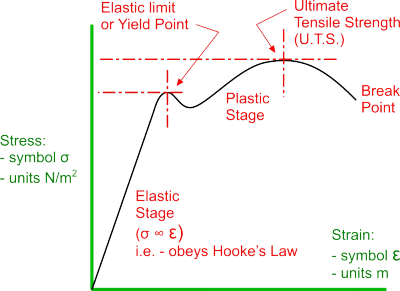Strain: Difference between revisions
From DT Online
(Created article) |
m (Added Category) |
||
| Line 13: | Line 13: | ||
The '''[[Stress]]''' divided by the '''Strain''' during the '''[[Young's Modulus|Elastic Stage]]''' is a measure of the '''stiffness''' of a material and is known as its '''[[Young's Modulus]]''' or '''Modulus of Elasticity'''. | The '''[[Stress]]''' divided by the '''Strain''' during the '''[[Young's Modulus|Elastic Stage]]''' is a measure of the '''stiffness''' of a material and is known as its '''[[Young's Modulus]]''' or '''Modulus of Elasticity'''. | ||
[[Category:Terminology]] | |||
Latest revision as of 19:13, 21 December 2015
As materials are loaded and subjected to some Stress they will deform either by stretching as a result of Tensile Forces or being squashed because of a Compressive Loading.
Strong materials may be deformed only by a microscopically small amount but in all cases, the resulting Strain is calculated as being equal to the change in length divided by the original length and is allocated the Greek letter ε (epsilon).
As a sample of materials is subjected to Stress and consequently deformed in some way, the values of Stress and Strain can be plotted against each other to create a Stress/Strain Curve as shown.
Such graphs can be used to determine the Elastic Limit and Ultimate Tensile Strength (U.T.S.) of a material.
The Stress divided by the Strain during the Elastic Stage is a measure of the stiffness of a material and is known as its Young's Modulus or Modulus of Elasticity.
